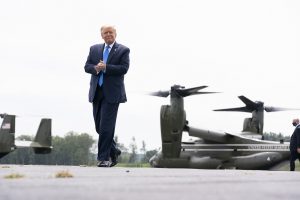By Catherine Putz
 The United States appears to be moving ahead with its plans to withdraw from Afghanistan.On September 9, during a visit to Iraq, the commander of U.S. Central Command (CENTROM) Marine Gen. Frank McKenzie told reporters in a telephone call that U.S. troop levels would fall to 4,500 by November.
The United States appears to be moving ahead with its plans to withdraw from Afghanistan.On September 9, during a visit to Iraq, the commander of U.S. Central Command (CENTROM) Marine Gen. Frank McKenzie told reporters in a telephone call that U.S. troop levels would fall to 4,500 by November.
“We’re on a glide slope to be at 4,500 by the November time frame — October, late October, November time frame,” the Associated Press reported McKenzie as saying.
“At 4,500 we’re still going to be able to accomplish the core tasks that we want to accomplish,” McKenzie said. “And we’ve shown more than ample goodwill and our willingness to demonstrate that we don’t want to be an occupying force in this country. But we do have strategic interests, vital interests, that compel us to be certain that these entities, such as al-Qaida and ISIS, can’t be guests there to attack the United States.”
By June, following a path charted in the late February U.S.-Taliban agreement, the United States had reduced its footprint in Afghanistan to around 8,600 troops. The deal calls for the U.S. to completely withdraw by spring 2021 but its language predicates that withdrawal on “the commitment and action on the obligations” set forth for the Taliban.
There are a few separate but related issues to consider at this juncture. President Donald Trump’s own sentiments about the war in Afghanistan, paired with the administration’s stated regional strategy and the timing of the withdrawal with the U.S. presidential election serve to obfuscate the lines between politics and policy.
The mantra of “bringing the troops home” has featured often in the presidency of Donald Trump. In the several years prior to his election he repeatedly questioned the U.S. presence in Afghanistan; that aside, the United States’ long-running war in the country was barely mentioned in the 2016 campaign and not directly mentioned at all in Trump’s 2016 speech accepting the Republican nomination or his January 2017 inauguration address. Trump’s 2020 Republican nomination acceptance speech made just one reference to Afghanistan, which is critical for understanding how Trump aims to frame U.S. policy in Afghanistan as he vies for a second term: “When I took office, the Middle East was in total chaos. ISIS was rampaging, Iran was on the rise, and the war in Afghanistan had no end in sight.”
Trump’s established personal distaste for the war in Afghanistan aside, when unveiling the administration’s new Afghanistan and South Asia strategy in August 2017, Trump echoed concerns common to military and traditional Republican circles in the decade prior about a “hasty withdrawal,” illustrated by a critique of the Obama administration for the withdrawal of U.S. troops from Iraq in 2011. The administration then framed its own plans as “a shift from a time-based approach to one based on conditions.”
The strategy was paired with a surge of troops back into Afghanistan. From a low of 8,400 at the end of the Obama administration, the U.S. presence increased to around 14,000 by November 2017. While subsequent withdrawals were advertised as such, the fact of the mater is that until June 2020, troop levels in Afghanistan were higher under Trump than in the closing Obama days.
The Trump administration’s regional strategy emphasizes “conditions” as the basis of further withdrawals.
“Conditions on the ground — not arbitrary timetables — will guide our strategy from now on,” Trump said in August 2017.
But while the 2017 strategy did not elucidate the specific conditions under consideration, the U.S.-Taliban deal did lay out certain conditions: “the commitment and action on the obligations” set forth for the Taliban. Those obligations include a series of steps “to prevent any group or individual, including al-Qaida, from using the soil of Afghanistan to threaten the security of the United States and its allies.”
After the deal was signed, while the Taliban largely ceased attacking American and coalition targets, attacks have continued against Afghan government forces. In addition, as a U.N. report earlier this year argued, the Taliban has not cut ties to al-Qaida. Given that the term “allies” is undefined in the agreement, whether the Taliban is violating that provision or not is in the eye of the beholder. The al-Qaida connection is less debatable, though easily denied and difficult to verify either way.
In one reading of the situation the “conditions” have not been met, but the withdrawal is proceeding along a timetable. That timetable is arguably not “arbitrary,” and instead aimed squarely at election day in the United States: November 3. McKenzie did not give a specific date, but instead an “October, late October, November time frame” — priming the withdrawal to be campaign candy.
No comments:
Post a Comment